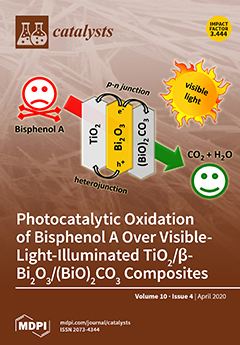Three different Advanced Oxidation Processes (AOPs) have been investigated for the degradation of the imidacloprid pesticide in water: photocatalysis, Fenton and photo-Fenton reactions. For these tests, we have compared the performance of two types of CeO
2, employed as a non-conventional photocatalyst/Fenton-like
[...] Read more.
Three different Advanced Oxidation Processes (AOPs) have been investigated for the degradation of the imidacloprid pesticide in water: photocatalysis, Fenton and photo-Fenton reactions. For these tests, we have compared the performance of two types of CeO
2, employed as a non-conventional photocatalyst/Fenton-like material. The first one has been prepared by chemical precipitation with KOH, while the second one has been obtained by exposing the as-synthetized CeO
2 to solar irradiation in H
2 stream. This latter treatment led to obtain a more defective CeO
2 (coded as “grey CeO
2”) with the formation of Ce
3+ sites on the surface of CeO
2, as determined by Raman and X-ray Photoelectron Spectroscopy (XPS) characterizations. This peculiar feature has been demonstrated as beneficial for the solar photo–Fenton reaction, with the best performance exhibited by the grey CeO
2. On the contrary, the bare CeO
2 showed a photocatalytic activity higher with respect to the grey CeO
2, due to the higher exposed surface area and the lower band-gap. The easy synthetic procedures of CeO
2 reported here, allows to tune and modify the physico-chemical properties of CeO
2, allowing a choice of different CeO
2 samples on the basis of the specific AOPs for water remediation. Furthermore, neither of the samples have shown any critical toxicity.
Full article





